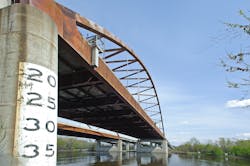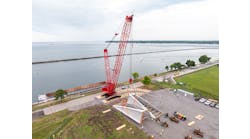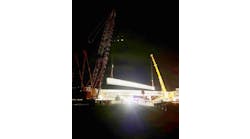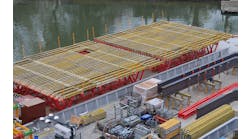By: Nick Busse
As the nation grapples with the challenge of maintaining its aging transportation infrastructure, states have sought innovative ways to monitor and manage their bridge inventories. In Minnesota, where the tragic collapse of the I-35W bridge is still a fresh memory nearly seven years later, bridge officials have pursued these emerging technologies with more than a passing interest.
Although investigators ultimately attributed the 2007 bridge failure to a design flaw, the incident inspired the Minnesota Department of Transportation (MnDOT) to seek out new techniques that could help prevent future catastrophes. That effort has yielded new knowledge about continuous bridge health monitoring systems.
Over the course of the last several years, MnDOT and a team of University of Minnesota researchers have quietly developed and deployed a new type of monitoring system on the Cedar Avenue Bridge, a major thoroughfare connecting Minneapolis and its south suburbs. Carrying approximately 87,000 commuters each day, the bridge houses a network of sensors, data loggers, modems and other equipment that might one day give inspectors an edge in detecting signs of structural distress.
“Minnesota, like many other states, has a large inventory of fracture-critical steel bridges. And the concern is, if there is a need to monitor one for fracture, can we do that?” said civil engineering professor Arturo Schultz, the project’s lead researcher.
The system works by detecting and recording the bridge’s acoustic emissions—stress waves caused by activity or events on the bridge. This includes everything from waves caused by traffic passing over the bridge deck to those produced by weather-related phenomena like rain.
What the sensors are actually listening for, however, is cracking. The project’s goal is to implement a semiautonomous system that can detect acoustic emissions on the bridge, differentiate between background noise and potential fracture events and then alert bridge engineers if and when something occurs that might warrant further investigation.
The system is not intended to serve as a replacement for normal bridge inspection techniques. Rather, it is designed to provide inspectors with a continuous monitoring capability in certain special circumstances—for example, when a bridge condition warrants close monitoring but not necessarily immediate action.
“If we’ve got a known issue that does not warrant immediate repair but is something that should be more closely monitored, we definitely think advanced monitoring could be an effective tool,” said Tom Styrbicki, MnDOT’s bridge inspection program manager.
The Cedar Avenue Bridge has no safety concerns. Schultz and his team are merely using it as a real-world laboratory to calibrate the system, check the data integrity and learn how to differentiate between types of acoustic emissions. It is a pilot project for a technology that proponents believe could help address a small but potentially significant gap in bridge-monitoring capabilities.
“The idea was to demonstrate that the system could be purchased, the system could be installed and could be used to monitor a bridge,” Schultz said.
Testing technology
MnDOT’s bridge office is no stranger to advanced monitoring technology. In addition to the visual and physical inspection techniques that make up the core of any bridge-inspection program, MnDOT has for many years employed technologies such as ultrasonic testing, infrared thermography, ground-penetrating radar and magnetic particle testing.
After the I-35W bridge collapse, however, MnDOT sought out new and emerging technologies that could help inspectors maximize the safety of the state’s more than 20,000 bridges. Of particular interest were technologies that could allow for continuous monitoring of bridge health, i.e., systems that could provide advance warning of distress in between a bridge’s regularly scheduled inspections.
MnDOT funded a research project to evaluate a wide range of state-of-the-art, commercially available bridge-monitoring systems. The study, completed in September 2009, developed a process and set of criteria for choosing the best monitoring technologies to fit the monitoring needs of a given bridge type.
Following that study, MnDOT contracted with Schultz to develop a system that would specifically address the issue of fracture-critical bridges, a designation used for nonredundant steel bridges that contain steel members in tension, or with a tension element, whose failure would probably cause the entire bridge or a portion of it to collapse (i.e., fracture-critical members). After researching the available options, officials and researchers quickly settled on acoustic-emissions technology.
“The acoustic emission was actually an easy decision,” Schultz said. “It was the only technology out there that can actually sense cracking directly. Other things would require us to know exactly where the crack is going to occur.”
MnDOT and the research team set their sights on the Cedar Avenue Bridge for a pilot deployment. Although fracture-critical, it has no history of cracking, and its box girders made for easy equipment installation—all of which made it an ideal candidate.
In January 2011, researchers began installing the equipment. They deployed a total of 32 sensors on the bridge, along with two data-loggers and modems to transfer the data via the Internet.
Location, location, location
The spacing of the sensors is key: As they move through steel, acoustic emissions attenuate, meaning the sensors might fail to detect them if they are spaced too far away from the source of the emission. Researchers had to space the sensors just close enough to each other so they would not miss any signals.
“The challenge we faced was how do you take a 300-ft-long girder and know where to put the sensors?” Schultz said. “We were using a local monitoring technology in a global sense.”
The team collected acoustic-emission data from the bridge for a 22-month period. In order to distinguish between false positives and actual fracture events, the researchers had previously conducted lab tests in which they simulated cracking using a steel beam. They compared the laboratory data to the data collected from the bridge and found that differences in acoustic-emission wave characteristics—hits vs. amplitude, duration vs. amplitude, hits vs. frequency, etc.—allowed them to make clear distinctions between cracking and other types of emissions.
“The trick with [acoustic-emission] sensors is to filter out all the background noise and know when you’re getting a fracture event,” said Anton Tillman, one of the researchers on the project. “Over a day, you can get a lot of crazy stuff (i.e., false positives).”
Schultz said the team is still working on two remaining issues with the system. One is establishing clear protocols for processing the data. The other is powering the system: MnDOT was unable to supply AC power to the bridge, so an array of four solar panels was installed along with a battery backup and other necessary equipment. This proved to be a problematic choice, as the solar panels turned out to be inadequate. To compound the problem, vandals attacked the solar panels repeatedly, requiring the installation of protective screens.
Overall, Schultz said they are now “pretty close” to a fully functional monitoring system ready for deployment. The next step would be to implement a kind of alarm capability, in which the system would automatically alert engineers and inspectors in the case of a fracture event.
Bridge schooling
The Cedar Avenue Bridge is not MnDOT’s only testing ground for continuous monitoring of bridges.
The new I-35W Saint Anthony Falls Bridge is itself a veritable laboratory of high-tech instrumentation. Built in 2008 to replace the old I-35W bridge, it houses a host of smart bridge technology, including vibrating-wire strain gauges, resistive strain gauges, fiber-optic strain gauges, accelerometers, thermistors and corrosion monitors. In all, 323 sensors record information on everything from traffic loads and temperature to expansion and contraction motions.
Styrbicki, who described the effort as “fairly unique,” said MnDOT has learned a number of lessons from the instrumentation installed on the Saint Anthony Falls Bridge. One is that MnDOT is not currently set up to continuously process and analyze the sheer amount of data produced by such systems. That role has fallen to researchers at the nearby University of Minnesota campus for now. Another is that the systems are expensive to install as well as maintain.
“That was a little bit of an eye-opener,” Styrbicki said. “We realized that these are relatively delicate sensors and technologies in a very harsh environment, and there’s an ongoing maintenance cost. The sensors wear out: It’s not ‘if they’ll fail,’ but rather ‘when they’ll fail,’” Styrbicki said.
The bigger and more important lesson, however, may be that continuous-monitoring technologies may not be necessary or even useful on all bridges. Styrbicki said some of the systems installed on the Saint Anthony Falls Bridge did not work as advertised, and the ones that did work basically told officials that the bridge was “extremely robust” and behaving as expected—something bridge inspectors could have discerned for themselves using traditional techniques.
“The majority of our bridges are load-path redundant, designed and constructed to modern codes and standards, inspected frequently and maintained by bridge crews, so we don’t see them as a risk that we need to mitigate through extensive monitoring,” Styrbicki said.
To be sure, the monitoring and analysis of the Saint Anthony Falls Bridge will help improve future bridge designs. But the upshot of MnDOT’s experience with continuous monitoring thus far is that it is not likely cost-effective to install these systems as a matter of course on all bridges.
Styrbicki said there are some cases, however, where continuous-monitoring capabilities might be useful. For example, the MnDOT bridge office has already deployed continuous-monitoring technology on a bridge in Winona, Minn., that recently experienced scour. Using devices like tilt meters and active sonar, bridge inspectors can now continuously monitor the areas around bridge piers for signs of erosion.
“We’ve detected some potential shifting and inclination of one of the piers,” he said. “That’s not something we could repair readily and it’s something we definitely want to monitor closely.”
In addition to allowing officials to ascertain the condition of bridge piers without having to send out dive teams during floods and other potentially hazardous situations, these continuous-monitoring devices will help engineers understand more about bridge scour and calibrate their methods of estimating it.
MnDOT bridge inspectors also are taking advantage of new noncontinuous-monitoring technologies like 3-D-imaging sonar to enhance their current inspection practices. Even inspections of timber bridges (of which Minnesota currently has more than 1,500) are getting a high-tech overhaul, with equipment like resistance microdrills and stress-wave timers.
As for Schultz’s system, its fate is unclear. Researchers will continue operating the system and collecting data until 2015, at which point MnDOT will have to decide whether to continue using it, deploy it on another bridge (possibly requiring significant modifications) or store it away for future needs. R&B
About The Author: Busse is a marketing and communication manager with the MnDOT Research Services & Library.



